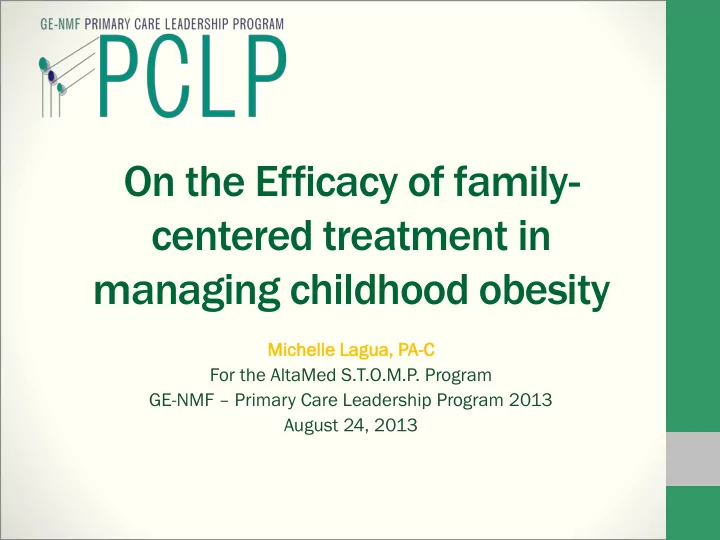

On the Efficacy of family- centered treatment in managing childhood obesity Michelle elle Lagua, ua, PA-C For the AltaMed S.T.O.M.P. Program GE-NMF – Primary Care Leadership Program 2013 August 24, 2013
Background • Childhood obesity affects 1 in 3 children in the US • AltaMed communities have a higher prevalence • Adults in AltaMed are obese as well • Main determinants for obesity are linked to diet and exercise: • Poor health literacy and ignorance of healthy lifestyles • Access to healthy options as opposed to high caloric foods • Lack of green space or limited resources prevent families from seeking low-cost exercise options
Introduction to STOMP • S.T.O.M.P. = Solutions & Treatment in Obesity Management and Prevention. • Modeled after AltaMed’s 1 st obesity clinic in Santa Ana • Based in Boyle Heights; enrolled based on BMI • Family-focused, long-term management • 1 consult/orientation prior to intervention • 12-weekly classes with a nutritionist (for parents) • 12-weekly exercise sessions with a physical activity specialist (for children) • 9 months of post-intervention follow-up
Tools: The STOMP Contract
Initial enrollment for STOMP in Boyle Heights Initial Enrollment # of Patients 5 9 6-8 years 9-12 years 13+ years 10
Methods: Tracking of BMI during the program • BMI was chosen as a Age Group # Patients # Patients quality measure: with with • easy to obtain BMI BMI • Cost-effective 6-8 years 3 3 • Not as affected by a child’s growth pattern • Measurements were taken 9-12 years 6 2 mid-way through the intervention 13+ years 2 1 Total 11 6
Results from the 6-8yr age group • Key findings from project BMI Tracking by Case: 6-8yrs age group • When relevant, include graphs, tables, charts, photos 6.000 4.000 2.000 Change in BMI Child's Δ in BMI 0.000 Parent's Δ in BMI Case 1 Case 2 Case 3 Case 4 Case 5 Case 6 -2.000 -4.000 -6.000
Results from the 9-12yr age group • Key findings from project BMI Tracking by Case: 9-12yrs age group • When relevant, include graphs, tables, charts, photos 1.000 0.500 0.000 Case 1 Case 2 Case 3 Case 4 Case 5 Case 6 Case 7 Case 8 -0.500 Change in BMI -1.000 Child's Δ in BMI Parent's Δ in BMI -1.500 -2.000 -2.500 -3.000 -3.500
Results from the 13+yr age group • Key findings from project BMI Tracking by Case: 9-12yrs age group BMI Tracking by Case: 13+yrs age group • When relevant, include graphs, tables, charts, photos 1.000 2.000 0.500 1.500 0.000 Case 1 Case 2 Case 3 Case 4 Case 5 Case 6 Case 7 Case 8 1.000 -0.500 0.500 Change in BMI -1.000 Change in BMI Child's Δ in BMI Child's Δ in BMI Parent's Δ in BMI 0.000 -1.500 Parent's Δ in BMI Case 1 Case 2 Case 3 -0.500 -2.000 -1.000 -2.500 -1.500 -3.000 -3.500 -2.000
Summary and Discussion: • There significant changes in BMI found in both children and parents during the intervention. • There was a direct correlation found between the change in a child’s BMI and their parent’s BMI. • For all children with BMI; their parents BMI as well. • For all children with BMI; their parents BMI. • Clinical significance: Parents’ participation is a key determinant in the effectiveness of any childhood obesity management program. • Parents should be held accountable for compliance with any obesity treatment plan.
Recommendations
Conclusion • One of the major barriers for effective treatment of childhood obesity is active participation from the parents. • Resistance at home may be encountered with regards to lifestyle changes and other treatment plans. • It is important to assess the parents’ willingness to comply with the STOMP program and identify areas for improvement with regard to: 1. entire household participation 2. choice of food and diet 4. exercise habits 3. other barriers to effective treatment.
Thank you!
Recommend
More recommend